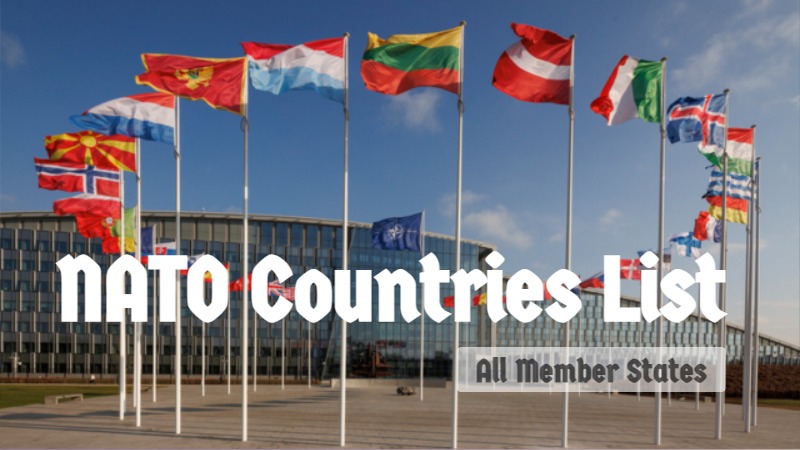
NATO countries list with country name, capital and date of accession, check names of 31 member states of NATO in alphabetical order. North Atlantic Treaty Organization, is an intergovernmental military alliance formed for the purposes of collective defense and security cooperation among its member states. It was established on April 4, 1949, with the signing of the North Atlantic Treaty, and its headquarters are located in Brussels, Belgium.
The primary goal of NATO is to safeguard the freedom and security of its member countries through political and military means. The organization operates on the principle of collective defense, meaning that an attack on one member is considered an attack on all, and the alliance is committed to responding collectively to such threats. There are 31 member states in NATO currently, each of which are listed here.
31 NATO Countries List 2023
| Country | Capital | Date of Accession |
|---|---|---|
| Albania | Tirana | 1-Apr-2009 |
| Belgium | Brussels | 24-Aug-1949 |
| Bulgaria | Sofia | 29-Mar-2004 |
| Canada | Ottawa | 24-Aug-1949 |
| Croatia | Zagreb | 1-Apr-2009 |
| Czech Republic | Prague | 12-Mar-1999 |
| Denmark | Copenhagen | 24-Aug-1949 |
| Estonia | Tallinn | 29-Mar-2004 |
| Finland | Helsinki | 4-Apr-2023 |
| France | Paris | 24-Aug-1949 |
| Germany | Berlin | 6 May 1955 (West Germany), 3 October 1990 (Germany) |
| Greece | Athens | 18-Feb-1952 |
| Hungary | Budapest | 12-Mar-1999 |
| Iceland | Reykjavík | 24-Aug-1949 |
| Italy | Rome | 24-Aug-1949 |
| Latvia | Riga | 29-Mar-2004 |
| Lithuania | Vilnius | 29-Mar-2004 |
| Luxembourg | Luxembourg | 24-Aug-1949 |
| Montenegro | Podgorica | 5-Jun-2017 |
| Netherlands | Amsterdam | 24-Aug-1949 |
| North Macedonia | Skopje | 27-Mar-2020 |
| Norway | Oslo | 24-Aug-1949 |
| Poland | Warsaw | 12-Mar-1999 |
| Portugal | Lisbon | 24-Aug-1949 |
| Romania | Bucharest | 29-Mar-2004 |
| Slovakia | Bratislava | 29-Mar-2004 |
| Slovenia | Ljubljana | 29-Mar-2004 |
| Spain | Madrid | 30-May-1982 |
| Türkiye | Ankara | 18-Feb-1952 |
| United Kingdom | London | 24-Aug-1949 |
| United States | Washington, D.C. | 24-Aug-1949 |
Salient Features of NATO
- NATO was created by 12 countries from Europe and North America on 4 April 1949.
- Since then, 19 more countries have joined NATO through nine rounds of enlargement (in 1952, 1955, 1982, 1999, 2004, 2009, 2017, 2020 and 2023).
- Article 10 of the North Atlantic Treaty sets out how countries can join the Alliance. It states that membership is open to any “European State in a position to further the principles of this Treaty and to contribute to the security of the North Atlantic area”.
- Any decision to invite a country to join the Alliance is taken by the North Atlantic Council, NATO’s principal political decision-making body, on the basis of consensus among all Allies.
12 Founding Members of NATO
The 12 founding members of NATO, who signed the North Atlantic Treaty on April 4, 1949, are:
- Belgium
- Canada
- Denmark
- France
- Iceland
- Italy
- Luxembourg
- Netherlands
- Norway
- Portugal
- United Kingdom
- United States
These 12 countries came together to form the North Atlantic Treaty Organization as a mutual defense alliance during the early years of the Cold War. The alliance has since expanded to include additional member states and now the number of countries in NATO has reached to 31.
Collective Defense of NATO Member States
NATO members engage in various activities to fulfill their collective defense responsibilities, including joint military exercises, sharing intelligence, coordinating defense policies, and providing mutual assistance in the event of an armed attack. NATO also engages in partnerships with non-member countries to promote security and stability.
Over the years, NATO has evolved to address new security challenges, such as terrorism, cyber threats, and non-state actors. It has also played a role in conflict resolution and peacekeeping operations in different parts of the world.
NATO member states contribute to the alliance through defense spending and cooperation, with the aim of maintaining a credible deterrent and ensuring the collective security of the member countries.










